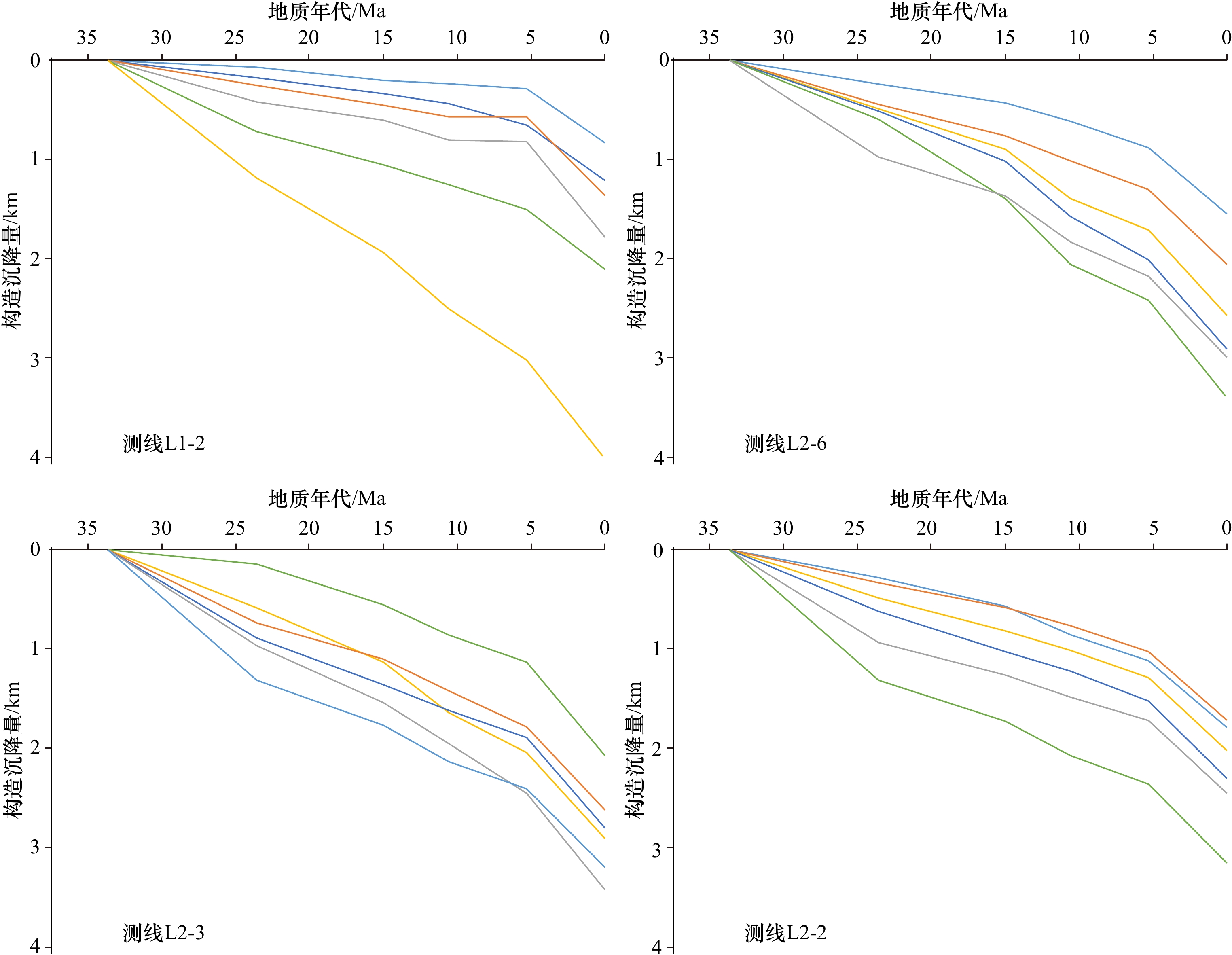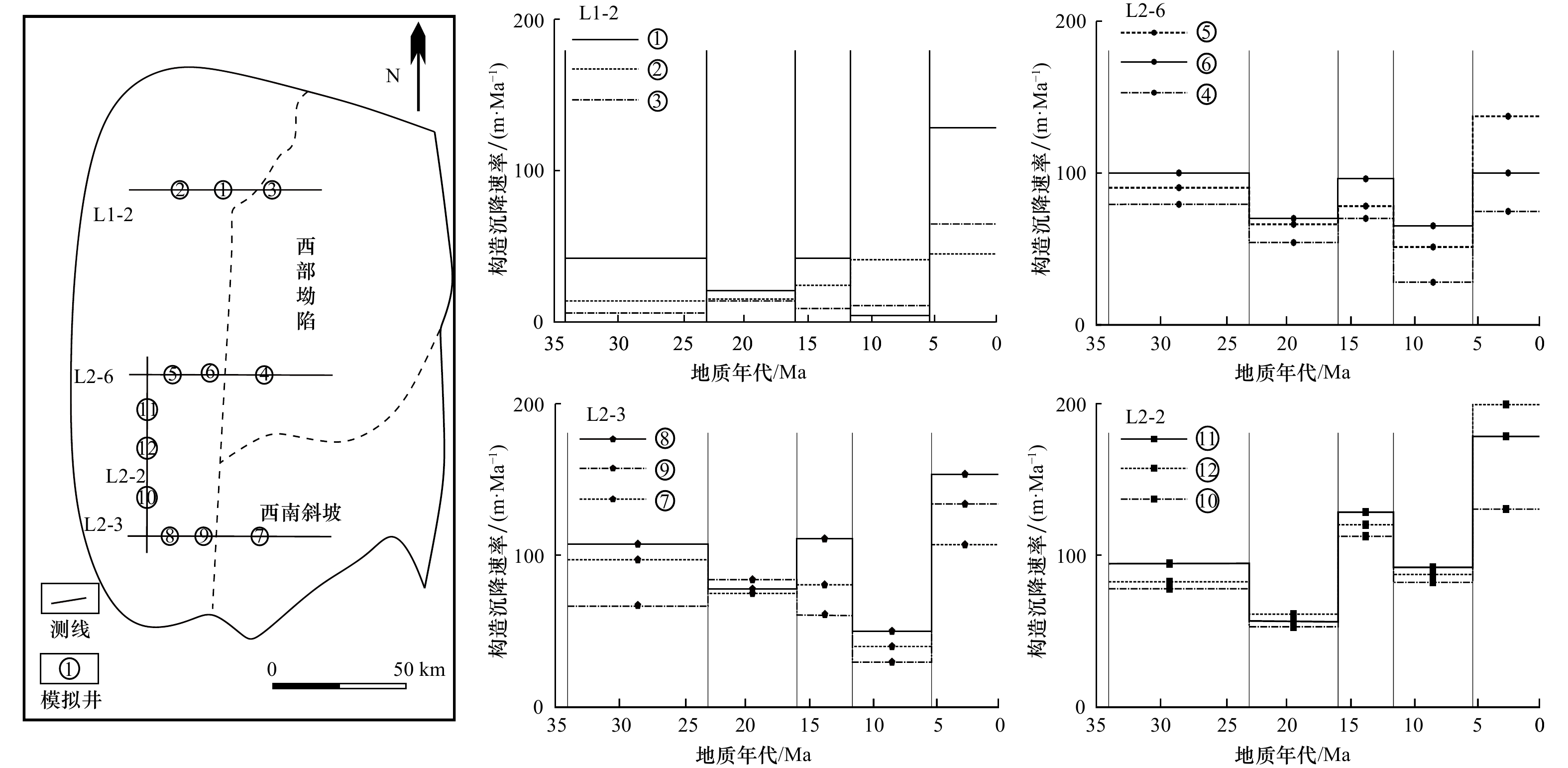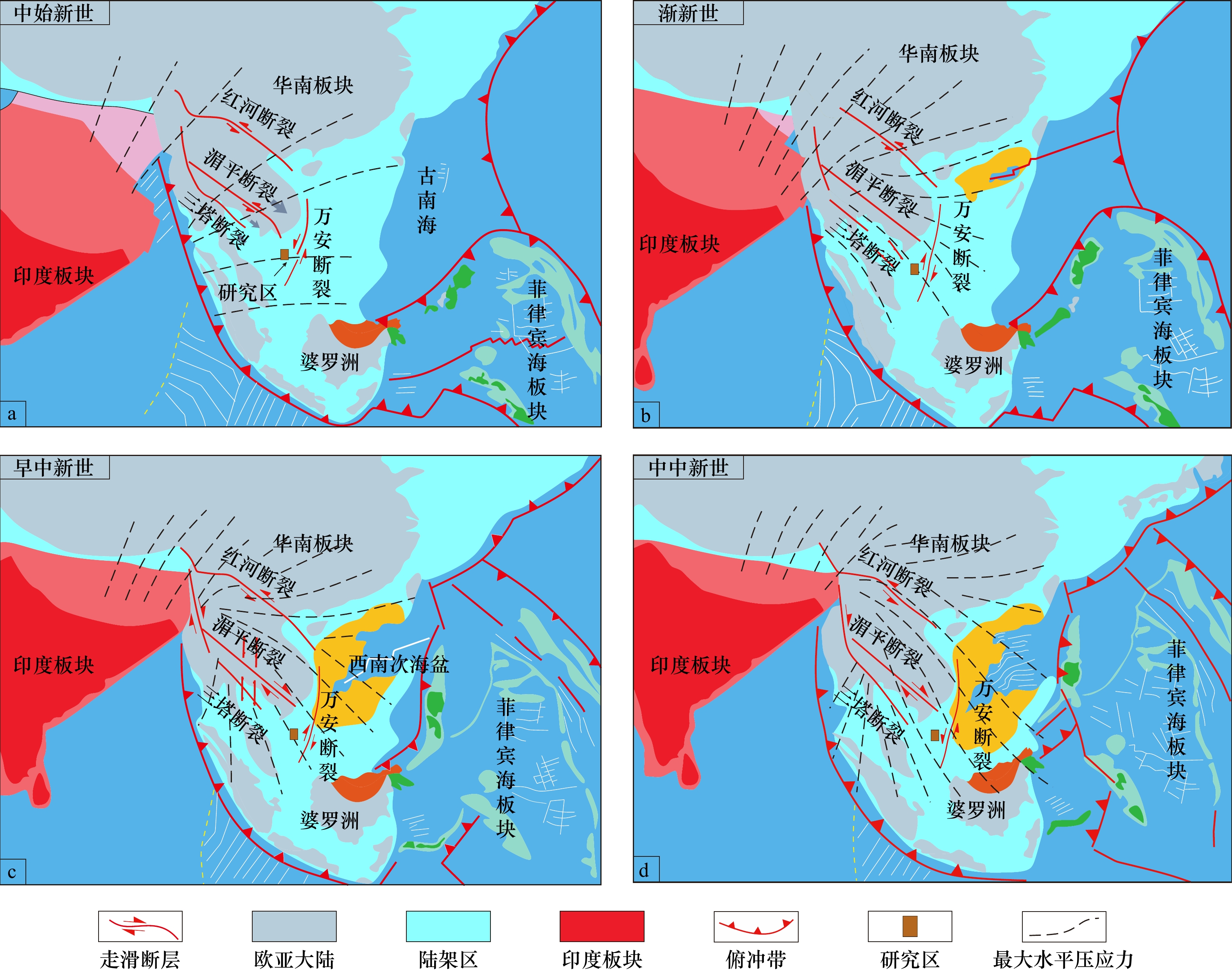| [1] |
Peltzer G, Tapponnier P. Formation and evolution of strike-slip faults, rifts, and basins during the India-Asia collision: an experimental approach[J]. Journal of Geophysical Research: Solid Earth, 1988, 93(B12): 15085−15117. doi: 10.1029/JB093iB12p15085
|
| [2] |
Tapponnier P, Peltzer G, Armijo R. On the mechanics of the collision between India and Asia[J]. Geological Society, London, Special Publications, 1986, 19(1): 113−157. doi: 10.1144/GSL.SP.1986.019.01.07
|
| [3] |
Tapponnier P, Peltzer G, Le Dain A Y, et al. Propagating extrusion tectonics in Asia: new insights from simple experiments with Plasticine[J]. Geology, 1982, 10(12): 611−616. doi: 10.1130/0091-7613(1982)10<611:PETIAN>2.0.CO;2
|
| [4] |
Tin N T, Ty N D. Petroleum geology of the Nam Con Son Basin[J]. Bulletin of the Geological Society of Malaysia, 1995, 37: 1−11. doi: 10.7186/bgsm37199501
|
| [5] |
Binh N T T, Tokunaga T, Son H P, et al. Present-day stress and pore pressure fields in the Cuu Long and Nam Con Son Basins, offshore Vietnam[J]. Marine and Petroleum Geology, 2007, 24(10): 607−615. doi: 10.1016/j.marpetgeo.2007.04.002
|
| [6] |
Li B J, Hoang P S, Van Mai B, et al. Fracture characterization using borehole image logs and seismic data to define a successful drilling target in the fractured basement-a case study from the Nam Con Son Basin, southern offshore Vietnam[C]//Proceedings of International Petroleum Technology Conference. Bangkok: OnePetro, 2011.
|
| [7] |
Binh N T T, Tokunaga T, Goulty N R, et al. Stress state in the Cuu Long and Nam Con Son Basins, offshore Vietnam[J]. Marine and Petroleum Geology, 2011, 28(5): 973−979. doi: 10.1016/j.marpetgeo.2011.01.007
|
| [8] |
姚永坚, 吕彩丽, 王利杰, 等. 南沙海区万安盆地构造演化与成因机制[J]. 海洋学报, 2018, 40(5): 62−74.Yao Yongjian, Lü Caili, Wang Lijie, et al. Tectonic evolution and genetic mechanism of the Wan’an Basin, southern South China Sea[J]. Haiyang Xuebao, 2018, 40(5): 62−74.
|
| [9] |
吴进民. 南海西南部人字形走滑断裂体系和曾母盆地的旋转构造[J]. 南海地质研究, 1997: 54−66.Wu Jinmin. The 人-type strikeslip fracture system and the convolute structure of Zengmu Basin in southwestern South China Sea[J]. Geological Study of South China Sea, 1997: 54−66.
|
| [10] |
解习农, 陈志宏, 孙志鹏, 等. 南海西北陆缘深水沉积体系内部构成特征[J]. 地球科学−中国地质大学学报, 2012, 37(4): 627−634.Xie Xinong, Chen Zhihong, Sun Zhipeng, et al. Depositional architecture characteristics of deepwater depositional systems on the continental margins of northwestern South China Sea[J]. Earth Science-Journal of China University of Geosciences, 2012, 37(4): 627−634.
|
| [11] |
解习农, 张成, 任建业, 等. 南海南北大陆边缘盆地构造演化差异性对油气成藏条件控制[J]. 地球物理学报, 2011, 54(12): 3280−3291. doi: 10.3969/j.issn.0001-5733.2011.12.026Xie Xinong, Zhang Cheng, Ren Jianye, et al. Effects of distinct tectonic evolutions on hydrocarbon accumulation in northern and southern continental marginal basins of South China Sea[J]. Chinese Journal of Geophysics, 2011, 54(12): 3280−3291. doi: 10.3969/j.issn.0001-5733.2011.12.026
|
| [12] |
Matthews S J, Fraser A J, Lowe S, et al. Structure, stratigraphy and petroleum geology of the SE Nam Con Son Basin, offshore Vietnam[J]. Geological Society, London, Special Publications, 1997, 126(1): 89−106. doi: 10.1144/GSL.SP.1997.126.01.07
|
| [13] |
Yarbrough C N. Pliocene to recent stratigraphy of the Cuu Long and Nam Con Son Basins, offshore Vietnam[D]. College Station: Texas A&M University, 2006.
|
| [14] |
杨振, 张光学, 张莉. 万安盆地生物礁及碳酸盐台地的发育演化及控制因素[J]. 地球科学, 2016, 41(8): 1349−1360.Yang Zhen, Zhang Guangxue, Zhang Li. The evolution and main controlling factors of reef and carbonate platform in Wan’an Basin[J]. Earth Science, 2016, 41(8): 1349−1360.
|
| [15] |
张光学. 地壳伸展及走滑与万安盆地的形成[J]. 南海地质研究, 1996: 14−23.Zhang Guangxue. The formation, crust extension and strike-slip tectionics of Wan’an Basin[J]. Geological Study of South China Sea, 1996: 14−23.
|
| [16] |
Giao P H, Trang P H, Hien D H, et al. Construction and application of an adapted rock physics template (ARPT) for characterizing a deep and strongly cemented gas sand in the Nam Con Son Basin, Vietnam[J]. Journal of Natural Gas Science and Engineering, 2021, 94: 104117. doi: 10.1016/j.jngse.2021.104117
|
| [17] |
Dung B V, Tuan H A, Van Kieu N, et al. Depositional environment and reservoir quality of Miocene sediments in the central part of the Nam Con Son Basin, southern Vietnam shelf[J]. Marine and Petroleum Geology, 2018, 97: 672−689. doi: 10.1016/j.marpetgeo.2018.05.004
|
| [18] |
Huchon P, Le Pichon X, Rangin C. Indochina peninsula and the collision of India and Eurasia[J]. Geology, 1994, 22(1): 27−30. doi: 10.1130/0091-7613(1994)022<0027:IPATCO>2.3.CO;2
|
| [19] |
Traynor J J, Sladen C. Seepage in Vietnam—onshore and offshore examples[J]. Marine and Petroleum Geology, 1997, 14(4): 345−362. doi: 10.1016/S0264-8172(96)00040-2
|
| [20] |
邓运华, 兰蕾, 李友川, 等. 论三角洲对南海海相油气田分布的控制作用[J]. 石油学报, 2019, 40(S2): 1−12.Deng Yunhua, Lan Lei, Li Youchuan, et al. On the control effect of deltas on the distribution of marine oil and gas fields in the South China Sea[J]. Acta Petrolei Sinica, 2019, 40(S2): 1−12.
|
| [21] |
Hall R. Reconstructing Cenozoic SE Asia[J]. Geological Society, London, Special Publications, 1996, 106(1): 153−184. doi: 10.1144/GSL.SP.1996.106.01.11
|
| [22] |
Hall R. Late Jurassic-Cenozoic reconstructions of the Indonesian region and the Indian Ocean[J]. Tectonophysics, 2012, 570−571: 1−41. doi: 10.1016/j.tecto.2012.04.021
|
| [23] |
孙龙涛, 孙珍, 詹文欢, 等. 南海西部断裂系研究及其物理模拟实验证据[J]. 海洋学报, 2006, 28(3): 64−71.Sun Longtao, Sun Zhen, Zhan Wenhuan, et al. Western fault zone of South China Sea and its physical simulation evidences[J]. Haiyang Xuebao, 2006, 28(3): 64−71.
|
| [24] |
刘振湖, 吴进民. 南海万安盆地油气地质特征[J]. 中国海上油气地质, 1997, 11(3): 153−160.Liu Zhenhu, Wu Jinmin. Petroleum geology of Wan’an Basin, South China Sea[J]. China Offshore Oil and Gas (Geology), 1997, 11(3): 153−160.
|
| [25] |
杨木壮, 王明君, 梁金强, 等. 南海万安盆地构造沉降及其油气成藏控制作用[J]. 海洋地质与第四纪地质, 2003, 23(2): 85−88. doi: 10.16562/j.cnki.0256-1492.2003.02.013Yang Muzhuang, Wang Mingjun, Liang Jinqiang, et al. Tectonic subsidence and its control on hydrocarbon resources in the Wan’an Basin in the South China Sea[J]. Marine Geology & Quaternary Geology, 2003, 23(2): 85−88. doi: 10.16562/j.cnki.0256-1492.2003.02.013
|
| [26] |
吴峧岐, 高红芳, 孙桂华. 南沙海域万安盆地地质构造与沉积体系特征[J]. 海洋地质与第四纪地质, 2012, 32(5): 1−11.Wu Jiaoqi, Gao Hongfang, Sun Guihua. Geological structure and sedimentary systems of the Wan’an Basin, Nansha waters[J]. Marine Geology & Quaternary Geology, 2012, 32(5): 1−11.
|
| [27] |
李三忠, 索艳慧, 刘鑫, 等. 南海的盆地群与盆地动力学[J]. 海洋地质与第四纪地质, 2012, 32(6): 55−78.Li Sanzhong, Suo Yanhui, Liu Xin, et al. Basin dynamics and basin groups of the South China Sea[J]. Marine Geology & Quaternary Geology, 2012, 32(6): 55−78.
|
| [28] |
Pugh A. Structural evolution of the Nam Con Son Basin: quantitative fault analysis applied to a 3-simensional seismic dataset[D]. County Durham: Durham University, 2007.
|
| [29] |
邹付戈, 尹宏伟. 四川龙门山地区反转构造样式分析及其成因机制探讨[J]. 大地构造与成矿学, 2009, 33(3): 321−333. doi: 10.3969/j.issn.1001-1552.2009.03.001Zou Fuge, Yin Hongwei. Analysis on the patterns and mechanism of inversion structures in Longmen Shan Region, Sichuan, China[J]. Geotectonica et Metallogenia, 2009, 33(3): 321−333. doi: 10.3969/j.issn.1001-1552.2009.03.001
|
| [30] |
李春峰, 宋陶然. 南海新生代洋壳扩张与深部演化的磁异常记录[J]. 科学通报, 2012, 57(24): 3165−3181. doi: 10.1007/s11434-012-5063-9Li Chunfeng, Song Taoran. Magnetic recording of the Cenozoic oceanic crustal accretion and evolution of the South China Sea basin[J]. Chinese Science Bulletin, 2012, 57(24): 3165−3181. doi: 10.1007/s11434-012-5063-9
|
| [31] |
王燮培, 严俊君, 林军. 反转构造及其石油地质意义[J]. 地球科学−中国地质大学学报, 1989, 14(1): 101−108. doi: 10.3321/j.issn:1000-2383.1989.01.003Wang Xiepei, Yan Junjun, Lin Jun. The inverted structure and its significance in petroleum geology[J]. Earth Science-Journal of China University of Geosciences, 1989, 14(1): 101−108. doi: 10.3321/j.issn:1000-2383.1989.01.003
|
| [32] |
Daly M C, Cooper M A, Wilson I, et al. Cenozoic plate tectonics and basin evolution in Indonesia[J]. Marine and Petroleum Geology, 1991, 8(1): 2−21. doi: 10.1016/0264-8172(91)90041-X
|
| [33] |
Nguyen H X, San N T, Bae W, et al. Formation mechanism and petroleum system of Tertiary sedimentary basins, offshore Vietnam[J]. Energy Sources, Part A: Recovery, Utilization, and Environmental Effects, 2014, 36(15): 1634−1649. doi: 10.1080/15567036.2010.551269
|
| [34] |
Lacassin R, Maluski H, Leloup P H, et al. Tertiary diachronic extrusion and deformation of western Indochina: structural and 40Ar/39Ar evidence from NW Thailand[J]. Journal of Geophysical Research: Solid Earth, 1997, 102(B5): 10013−10037. doi: 10.1029/96JB03831
|
| [35] |
Morley C K, Smith M, Carter A, et al. Evolution of deformation styles at a major restraining bend, constraints from cooling histories, Mae Ping fault zone, western Thailand[J]. Geological Society, London, Special Publications, 2007, 290(1): 325−349. doi: 10.1144/SP290.12
|
| [36] |
Rangin C, Jolivet L, Pubellier M. A simple model for the tectonic evolution of southeast Asia and Indonesia region for the past 43 m. y[J]. Bulletin de la Société Géologique de France, 1990, 6(6): 889−905.
|
| [37] |
Wang Peiling, Lo C H, Chung S L, et al. Onset timing of left-lateral movement along the Ailao Shan-Red River shear zone: 40Ar/39Ar dating constraint from the Nam Dinh area, northeastern Vietnam[J]. Journal of Asian Earth Sciences, 2000, 18(3): 281−292. doi: 10.1016/S1367-9120(99)00064-4
|
| [38] |
Yang Zhenyu, Besse J. Paleomagnetic study of Permian and Mesozoic sedimentary rocks from northern Thailand supports the extrusion model for Indochina[J]. Earth and Planetary Science Letters, 1993, 117(3/4): 525−552.
|
| [39] |
Lacassin R, Replumaz A, Hervé Leloup P. Hairpin river loops and slip-sense inversion on southeast Asian strike-slip faults[J]. Geology, 1998, 26(8): 703−706. doi: 10.1130/0091-7613(1998)026<0703:HRLASS>2.3.CO;2
|
| [40] |
Liu Y Y, Morinaga H. Cretaceous palaeomagnetic results from HAINAN ISLAND in South China supporting the extrusion model of southeast Asia[J]. Tectonophysics, 1999, 301(1/2): 133−144.
|
| [41] |
Yan C, Courtillot V. Widespread Cenozoic (?) remagnetization in Thailand and its implications for the India-Asia collision[J]. Earth and Planetary Science Letters, 1989, 93(1): 113−122. doi: 10.1016/0012-821X(89)90189-1
|
| [42] |
Rhodes B P, Charusiri P, Kosuwan S, et al. Tertiary evolution of the Three Pagodas Fault, western Thailand[C]//Proceedings of the International Conference on Geology, Geotechnology, and Mineral Resources of Indochina Thailand: Khon Kaen University, 2005: 498−505.
|
| [43] |
栾锡武, 张亮. 南海构造演化模式: 综合作用下的被动扩张[J]. 海洋地质与第四纪地质, 2009, 29(6): 59−74.Luan Xiwu, Zhang Liang. Tectonic evolution modes of South China Sea: passive spreading under complex actions[J]. Marine Geology & Quaternary Geology, 2009, 29(6): 59−74.
|
| [44] |
栾锡武, 王嘉, 刘鸿, 等. 关于南海北部特提斯的讨论[J]. 地球科学, 2021, 46(3): 866−884.Luan Xiwu, Wang Jia, Liu Hong, et al. A discussion on Tethys in northern margin of South China Sea[J]. Earth Science, 2021, 46(3): 866−884.
|
| [45] |
Morley C K. A tectonic model for the tertiary evolution of Strike-Slip faults and rift basins in SE Asia[J]. Tectonophysics, 2002, 347(4): 189−215. doi: 10.1016/S0040-1951(02)00061-6
|
| [46] |
Morley C K. Discussion of tectonic models for Cenozoic strike-slip fault-affected continental margins of mainland SE Asia[J]. Journal of Asian Earth Sciences, 2013, 76: 137−151. doi: 10.1016/j.jseaes.2012.10.019
|
| [47] |
Achache J, Courtillot V. A preliminary upper Triassic paleomagnetic pole for the Khorat Plateau (Thailand): consequences for the accretion of Indochina against Eurasia[J]. Earth and Planetary Science Letters, 1985, 73(1): 147−157. doi: 10.1016/0012-821X(85)90042-1
|
| [48] |
Holloway N H. North Palawan block, Philippines-its relation to Asian mainland and role in evolution of South China Sea[J]. AAPG Bulletin, 1982, 66(9): 1355−1383.
|
| [49] |
Rhodes B P, Perez R, Lamjuan A, et al. Kinematics and tectonic implications of the Mae Kuang fault, northern Thailand[J]. Journal of Asian Earth Sciences, 2004, 24(1): 79−89. doi: 10.1016/j.jseaes.2003.09.008
|
| [50] |
邱燕, 曾维军, 李唐根. 南海中、南部断裂体系及其构造意义[J]. 大地构造与成矿学, 2005, 29(2): 166−175. doi: 10.3969/j.issn.1001-1552.2005.02.002Qiu Yan, Zeng Weijun, Li Tanggen. Fracture systems and their tectonic significance in the central and southern parts of the South China Sea[J]. Geotectonica et Metallogenia, 2005, 29(2): 166−175. doi: 10.3969/j.issn.1001-1552.2005.02.002
|
| [51] |
Lee T Y, Lawver L A. Cenozoic plate reconstruction of southeast Asia[J]. Tectonophysics, 1995, 251(1/4): 85−138.
|
| [52] |
孙珍, 李付成, 林间, 等. 被动大陆边缘张-破裂过程与岩浆活动: 南海的归属[J]. 地球科学, 2021, 46(3): 770−789.Sun Zhen, Li Fucheng, Lin Jian, et al. The rifting-breakup process of the passive continental margin and its relationship with magmatism: the Attribution of the South China Sea[J]. Earth Science, 2021, 46(3): 770−789.
|
| [53] |
栾锡武. 东南亚构造分区[J]. 地球科学进展, 2022, 37(3): 221−252. doi: 10.11867/j.issn.1001-8166.2022.023Luan Xiwu. Tectonic divisions of southeast Asia[J]. Advances in Earth Science, 2022, 37(3): 221−252. doi: 10.11867/j.issn.1001-8166.2022.023
|





 下载:
下载:










